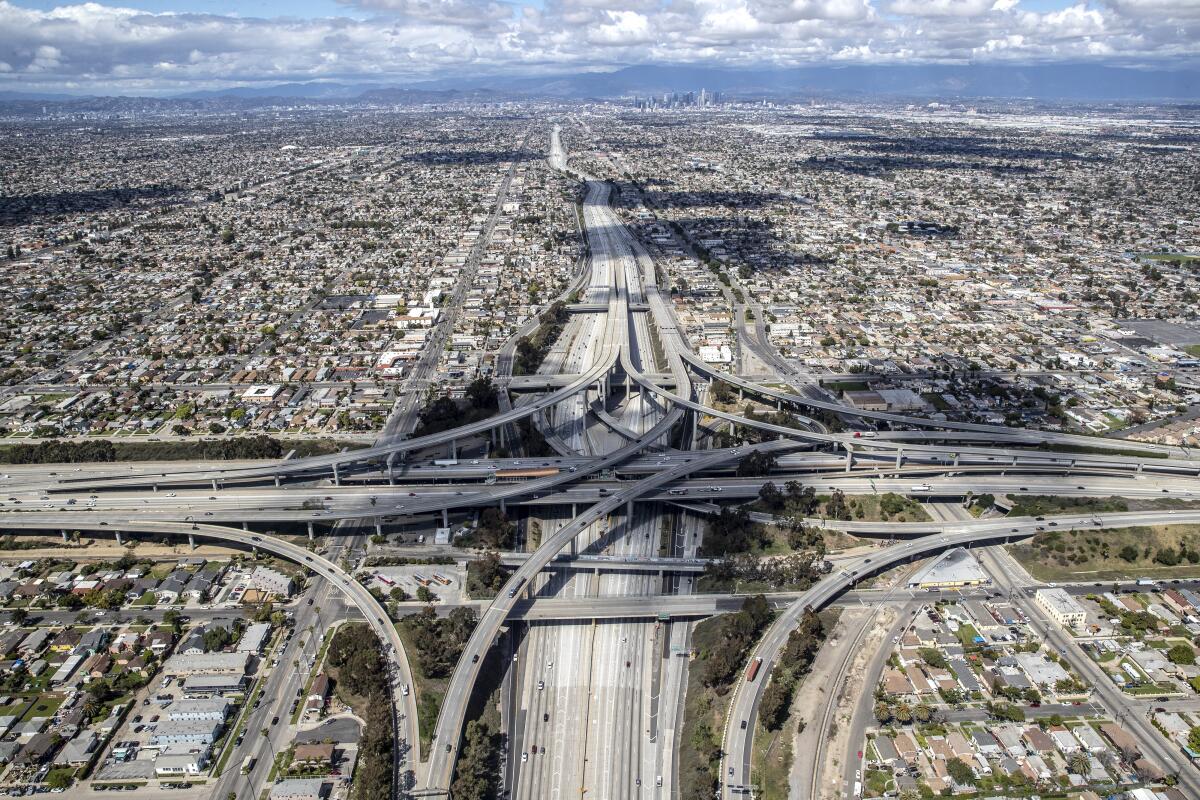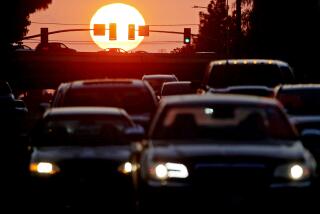Coronavirus stay-at-home orders have reduced traffic accidents by half

- Share via
Coronavirus stay-at-home orders that went into effect on March 20 have reduced vehicle collisions on California roadways by roughly half, according to a UC Davis survey that is the first to estimate the impact of the extraordinary health orders on traffic.
“The reduction works out to about 15,000 fewer collisions per month and 6,000 fewer injury accidents per month,” said Fraser Shilling, co-director of the Road Ecology Center at UC Davis. Shilling said the reduction in motor vehicle accidents on highways and roads “can be directly or indirectly attributed to the shelter-in-place order.”
The survey suggests that a 60% drop in traffic volume — when compared with the same period last year — accounts for a roughly 50% decline in collisions on roadways policed by California Highway Patrol.
As people have limited their vehicular use to traveling to work and obtaining food and other essentials, it was predictable that collisions would decrease. And with bars and restaurants shuttered, there would be even fewer drunk driving accidents.
But Shilling was surprised by the extent of the reduction.
“We’ve never had a statewide experiment like this before,” he said, “where you severely reduced traffic and then in real time monitor the public health implications of less vehicles and their pollution.”
He said it is unlikely, however, that stay-at-home orders in California and across the nation would mean the number of lives spared in traffic accidents would exceed the number of lives claimed by the coronavirus.
Hoping to escape the spread of coronavirus, these Californians are fleeing to the deserts and mountains. Some locals wish they had stayed home.
Susan Handy, a professor of environmental science and director of the National Center for Sustainable Transportation at UC Davis, described Shilling’s findings as “an important reminder of how hazardous our normal lives have become.”
Using data derived from California Highway Patrol incident reports, the survey compared the average daily number of collisions on state highways and roads between March 10 and 19, 2019 and March 21 and 30, 2019 with those reported during the same periods in 2020.
The average daily number of collisions reported in the 10 days prior to the stay-at-home order was 1,116, compared with 500 per day after the order was issued by Gov. Gavin Newsom.
Similarly, the average daily number of vehicle collisions involving injuries and fatalities in the 10 days prior to the order was 562, compared with 274 per day in the 10 days after the order was issued.
Overall, the reduction in traffic accidents was evenly distributed throughout the state, Shilling said. Although major transportation routes that support freight movement such as the 5, 10, 15 and 101 Freeways in Southern California, for example, “are seeing a little less traffic,” he said, “urban highways normally traversed daily by tens of thousands of commuters are experiencing significant reductions in numbers of vehicles.”
Normally, Shilling’s research focuses on animals that are killed on public roadways. In this case, the survey was unable to collect enough data to accurately gauge changes in the number of animal deaths. “We need a longer time frame of information for that,” Shilling said.
The UC Davis Road Ecology Center was established to help design transportation systems, including highways, that take into account their impact on natural landscapes and urban centers.
Cheryl Brehme, a biologist with the U.S. Geological Survey, believes that reduced traffic in rural settings “is promoting safer crossings for a variety of species at a time of the year when they’re migrating to breeding habitat within their home ranges: toads, newts, deer, coyotes, badgers.”
“Regardless of any short-term effects from changes in traffic volume on the mortality rates of wildlife,” she said, “it is important for us to provide safe crossing structures such as underpasses and overpasses to connect populations and habitats. This will help to ensure wildlife species and communities persist in the long term.”
So far, research biologists have seen no evidence that Southern California’s increasingly isolated and inbred populations of mountain lions are benefiting from far fewer vehicles on freeways cutting across their ever-shrinking islands of habitat.
“There is no evidence that the animals that we’re tracking are crossing freeways any more in the last couple of weeks,” said Seth P.D. Riley, wildlife ecologist and branch chief for the National Park Service’s Santa Monica Mountains Recreation Area. “But that is not too surprising — it is a very short time frame.”
Mountain lions are not endangered in California, but groups living in the Santa Monica and Santa Ana ranges now find themselves in genetic peril. Separated by nearly impenetrable freeways and lethal traffic, they are unable to travel and are growing increasingly rare and inbred, researchers say.
The California Fish and Game Commission on April 16 is expected to decide whether to recommend listing lion populations in Central and Southern California as a state endangered species.
In the meantime, the National Center for Sustainable Transportation and the Institute of Transportation Studies at UC Davis have made funding requests to support research aimed at probing deeper into the positive and negative impacts of the pandemic on social rhythms of life.
“As the shelter in place order extends over months,” Shilling said, “we hope to answer pressing questions such as this one: What are the cost-savings and other social benefits from reduced injuries and deaths on state highways due to COVID-19?”










